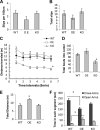The chromatin-binding protein HMGN1 regulates the expression of methyl CpG-binding protein 2 (MECP2) and affects the behavior of mice
- PMID: 22009741
- PMCID: PMC3234940
- DOI: 10.1074/jbc.M111.300541
The chromatin-binding protein HMGN1 regulates the expression of methyl CpG-binding protein 2 (MECP2) and affects the behavior of mice
Abstract
High mobility group N1 protein (HMGN1), a nucleosomal-binding protein that affects the structure and function of chromatin, is encoded by a gene located on chromosome 21 and is overexpressed in Down syndrome, one of the most prevalent genomic disorders. Misexpression of HMGN1 affects the cellular transcription profile; however, the biological function of this protein is still not fully understood. We report that HMGN1 modulates the expression of methyl CpG-binding protein 2 (MeCP2), a DNA-binding protein known to affect neurological functions including autism spectrum disorders, and whose alterations in HMGN1 levels affect the behavior of mice. Quantitative PCR and Western analyses of cell lines and brain tissues from mice that either overexpress or lack HMGN1 indicate that HMGN1 is a negative regulator of MeCP2 expression. Alterations in HMGN1 levels lead to changes in chromatin structure and histone modifications in the MeCP2 promoter. Behavior analyses by open field test, elevated plus maze, Reciprocal Social Interaction, and automated sociability test link changes in HMGN1 levels to abnormalities in activity and anxiety and to social deficits in mice. Targeted analysis of the Autism Genetic Resource Exchange genotype collection reveals a non-random distribution of genotypes within 500 kbp of HMGN1 in a region affecting its expression in families predisposed to autism spectrum disorders. Our results reveal that HMGN1 affects the behavior of mice and suggest that epigenetic changes resulting from altered HMGN1 levels could play a role in the etiology of neurodevelopmental disorders.
Figures






Similar articles
-
Shaking up the silence: consequences of HMGN1 antagonizing PRC2 in the Down syndrome brain.Epigenetics Chromatin. 2022 Dec 3;15(1):39. doi: 10.1186/s13072-022-00471-6. Epigenetics Chromatin. 2022. PMID: 36463299 Free PMC article. Review.
-
Chromosomal protein HMGN1 modulates the expression of N-cadherin.FEBS J. 2005 Nov;272(22):5853-63. doi: 10.1111/j.1742-4658.2005.04980.x. FEBS J. 2005. PMID: 16279949 Free PMC article.
-
Chromosomal protein HMGN1 modulates histone H3 phosphorylation.Mol Cell. 2004 Aug 27;15(4):573-84. doi: 10.1016/j.molcel.2004.08.006. Mol Cell. 2004. PMID: 15327773
-
Chromosomal protein HMGN1 enhances the heat shock-induced remodeling of Hsp70 chromatin.J Biol Chem. 2008 Mar 28;283(13):8080-8. doi: 10.1074/jbc.M709782200. Epub 2008 Jan 24. J Biol Chem. 2008. PMID: 18218636 Free PMC article.
-
MeCP2 and the enigmatic organization of brain chromatin. Implications for depression and cocaine addiction.Clin Epigenetics. 2016 May 21;8:58. doi: 10.1186/s13148-016-0214-5. eCollection 2016. Clin Epigenetics. 2016. PMID: 27213019 Free PMC article. Review.
Cited by
-
Shaking up the silence: consequences of HMGN1 antagonizing PRC2 in the Down syndrome brain.Epigenetics Chromatin. 2022 Dec 3;15(1):39. doi: 10.1186/s13072-022-00471-6. Epigenetics Chromatin. 2022. PMID: 36463299 Free PMC article. Review.
-
Genome-wide association study of major anxiety disorders in 122,341 European-ancestry cases identifies 58 loci and highlights GABAergic signaling.medRxiv [Preprint]. 2024 Jul 5:2024.07.03.24309466. doi: 10.1101/2024.07.03.24309466. medRxiv. 2024. PMID: 39006447 Free PMC article. Preprint.
-
Nucleosome structural changes induced by binding of non-histone chromosomal proteins HMGN1 and HMGN2.FEBS Open Bio. 2013 Mar 28;3:184-91. doi: 10.1016/j.fob.2013.03.002. Print 2013. FEBS Open Bio. 2013. PMID: 23772392 Free PMC article.
-
Rett syndrome and MeCP2.Neuromolecular Med. 2014 Jun;16(2):231-64. doi: 10.1007/s12017-014-8295-9. Epub 2014 Mar 11. Neuromolecular Med. 2014. PMID: 24615633 Free PMC article. Review.
-
Retinal Pigment Epithelium Specific Metabolic Phenotypes Are Regulated by High-Mobility Group Protein N1.Invest Ophthalmol Vis Sci. 2025 Apr 1;66(4):70. doi: 10.1167/iovs.66.4.70. Invest Ophthalmol Vis Sci. 2025. PMID: 40272371 Free PMC article.
References
-
- Kugathasan S., Baldassano R. N., Bradfield J. P., Sleiman P. M., Imielinski M., Guthery S. L., Cucchiara S., Kim C. E., Frackelton E. C., Annaiah K., Glessner J. T., Santa E., Willson T., Eckert A. W., Bonkowski E., Shaner J. L., Smith R. M., Otieno F. G., Peterson N., Abrams D. J., Chiavacci R. M., Grundmeier R., Mamula P., Tomer G., Piccoli D. A., Monos D. S., Annese V., Denson L. A., Grant S. F., Hakonarson H. (2008) Nat. Genet. 40, 1211–1215 - PMC - PubMed
-
- Scherr R., Essers J., Hakonarson H., Kugathasan S. (2009) Dig. Dis. 27, 236–239 - PubMed
-
- Murata K., Degmetich S., Kinoshita M., Shimada E. (2009) Dev. Growth Differ. 51, 95–107 - PubMed
-
- Bustin M., Trieschmann L., Postnikov Y. V. (1995) Semin Cell Biol. 6, 247–255 - PubMed
Publication types
MeSH terms
Substances
Grants and funding
LinkOut - more resources
Full Text Sources
Molecular Biology Databases
Miscellaneous

